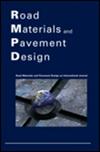Influence of physical properties and chemical compositions of bitumen on foam characteristics
IF 3
3区 工程技术
Q2 CONSTRUCTION & BUILDING TECHNOLOGY
引用次数: 0
Abstract
AbstractThis study explores the influence of intrinsic bitumen properties on foam characteristics, considering physical properties (penetration, softening point, viscosity), chemical compositions (SARA components, FTIR indices), and physico-chemical characteristics [surface free energy (SFE)]. Ten distinct bitumen samples from two different sources were analyzed. The results reveal that physical properties alone do not sufficiently account for variations in foaming potential among bitumen types. However, chemical compositions and SFE proved to be more informative, explaining the differences in maximum expansion ratio and foam index, specifically for bitumen from the same source. In contrast, when bitumen originates from different sources, none of these intrinsic properties can clarify foaming potential. Notably, intrinsic bitumen properties fail to elucidate the variability in the half-life of foamed bitumen, even when the bitumen types share the same source. These findings underscore the significance of considering multiple factors when assessing bitumen's foam characteristics, particularly when evaluating materials from diverse sources.KEYWORDS: Foamed bitumenfoam characteristicsphysical properties of bitumenchemical compositions of bitumenbitumen sourcecorrelation analysis Disclosure statementNo potential conflict of interest was reported by the author(s).沥青物理性质和化学成分对泡沫特性的影响
摘要本研究从物理性质(渗透度、软化点、粘度)、化学成分(SARA组分、FTIR指数)和理化性质(表面自由能)等方面探讨了沥青固有性质对泡沫特性的影响。分析了来自两个不同来源的10种不同沥青样品。结果表明,物理性质本身并不能充分说明不同沥青类型之间泡沫电位的变化。然而,化学成分和SFE证明了更多的信息,解释了最大膨胀比和泡沫指数的差异,特别是对于来自同一来源的沥青。相比之下,当沥青的来源不同时,这些固有性质都不能澄清泡沫潜力。值得注意的是,即使沥青类型具有相同的来源,其固有沥青性质也无法解释泡沫沥青半衰期的变化。这些发现强调了在评估沥青泡沫特性时考虑多种因素的重要性,特别是在评估不同来源的材料时。关键词:泡沫沥青;泡沫特性;沥青物理性质;;
本文章由计算机程序翻译,如有差异,请以英文原文为准。
求助全文
约1分钟内获得全文
求助全文
来源期刊

Road Materials and Pavement Design
工程技术-材料科学:综合
CiteScore
8.10
自引率
8.10%
发文量
105
审稿时长
3 months
期刊介绍:
The international journal Road Materials and Pavement Design welcomes contributions on mechanical, thermal, chemical and/or physical properties and characteristics of bitumens, additives, bituminous mixes, asphalt concrete, cement concrete, unbound granular materials, soils, geo-composites, new and innovative materials, as well as mix design, soil stabilization, and environmental aspects of handling and re-use of road materials.
The Journal also intends to offer a platform for the publication of research of immediate interest regarding design and modeling of pavement behavior and performance, structural evaluation, stress, strain and thermal characterization and/or calculation, vehicle/road interaction, climatic effects and numerical and analytical modeling. The different layers of the road, including the soil, are considered. Emerging topics, such as new sensing methods, machine learning, smart materials and smart city pavement infrastructure are also encouraged.
Contributions in the areas of airfield pavements and rail track infrastructures as well as new emerging modes of surface transportation are also welcome.
 求助内容:
求助内容: 应助结果提醒方式:
应助结果提醒方式:


